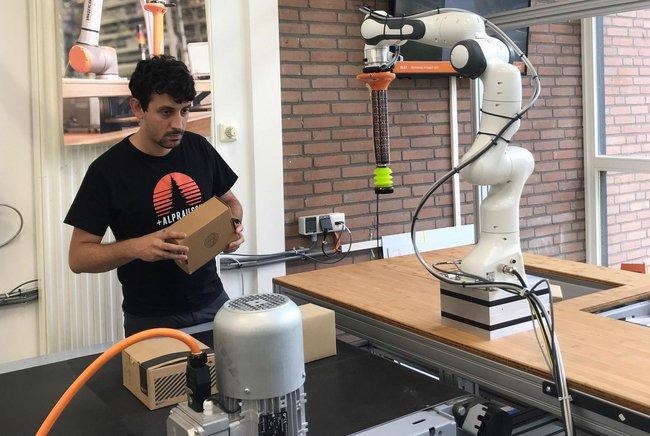
Image Credit: Marco Fattori.
If sensors were placed on robots to spot a person, then these problems could be resolved, but existing sensors depend on inflexible, impractical, and thick electronics. Eindhoven University of Technology (TU/e) scientists have engineered a method to create flexible, thin, and accurate sensor electronics that outperform a number of existing sensors. The new innovation has been detailed in the journal Nature Electronics.
The world is full of robots. From robot dog walkers to robot vacuum cleaners, robots have been incorporated into many areas of everyday life. In industry, robots are used to automate several operations, and in the process, they offer both speed and accuracy that are outside the abilities of human beings.
Nevertheless, that does not mean that robots and humans do not function closely together in industry.
Many industrial operations require close human-robot interactions. This means that the robots need accurate proximity sensors to check if someone gets too close to the robot. Once someone is detected, the robot shuts down to prevent any injuries to the person.
Marco Fattori, Researcher, Department of Electrical Engineering, TU/e
Fattori is also part of TU/e startup MicroAlign.
A number of the existing sensors rely on silicon parts, but these are inflexible and thick, which makes it tough and expensive to position them on the robot’s surface.
New Flexible Printed Electronics
The alternative is flexible printed electronics, but this kind of electronics has lower capabilities compared to silicon chips. Flexible electronics are slow and noisy, which negatively affects its accuracy. But unlike silicon sensors, the flexible ones can be placed over large surface areas, are cheap to make, and can be produced in large quantities.
Eugenio Cantatore, Researcher, Department of Electrical Engineering, TU/e
Therefore, to solve the problem of creating accurate malleable electronics, Cantatore and Fattori, in partnership with scientists based in Austria, France and the UK, built new flexible electronics by printing polymer-based organic materials. The printing method allows for the positioning of front-end electronics (the first layer of electronics after the sensor) in each pixel of the device.
In effect, we printed electronics on a plastic or foil sheet, then we placed the sensors on another foil. After that we laminated the two foils together, leading to an ultra-flexible and thin sensor. This combination enhances signal quality in comparison to previous sensors.
Marco Fattori, Researcher, Department of Electrical Engineering, TU/e
The Robot Arm
For this research, the scientists positioned long-wavelength infrared organic pyroelectric sensors (heat sensors) in the versatile foil.
“We created a large flexible sheet filled with heat sensors that can be used to cover a structure, such as a robotic arm for example,” says Cantatare.
That was exactly what the scientists did. They wrapped a flexible sheet of heat sensors around a robotic arm to mimic an industrial work setting where a human works in close proximity to a robot.
The flexible sensor acts like a sort of ‘artificial skin’ for the robot. The heat sensors allow the robot to detect the presence of a moveable heat source, such as a person, from a distance of up to 0.4 meters away. What’s more, the sensors can also detect a human hand approaching from different directions and not just from directly in front of it.
Marco Fattori, Researcher, Department of Electrical Engineering, TU/e
Great Promise
In addition to robotic applications in industry, the scientists observe that the ability to create inexpensive flexible sensors could be beneficial in several other fields, like healthcare.
For instance, they could be employed to chart pressure distributions on a mattress, and thereby help patients prevent bedsores. Furthermore, they could be employed to monitor if an elderly person has fallen down at home or in a care home by implanting sensors into the floors. These types of sensors could even be modified to track the integrity of airplane wings.
This study is part of a complex European collaborative project known as ATLASS.
After years of work, we have demonstrated for the first time with a practical, useful example, the great promise of low-cost printed sensing surfaces that include electronics. We are excited to use these results to initiate new research endeavors at TU/e.
Eugenio Cantatore, Department of Electrical Engineering, TU/e
Journal Reference:
Fattori, M., et al. (2022) A printed proximity-sensing surface based on organic pyroelectric sensors and organic thin-film transistor electronics. Nature Electronics . doi.org/10.1038/s41928-022-00762-6.